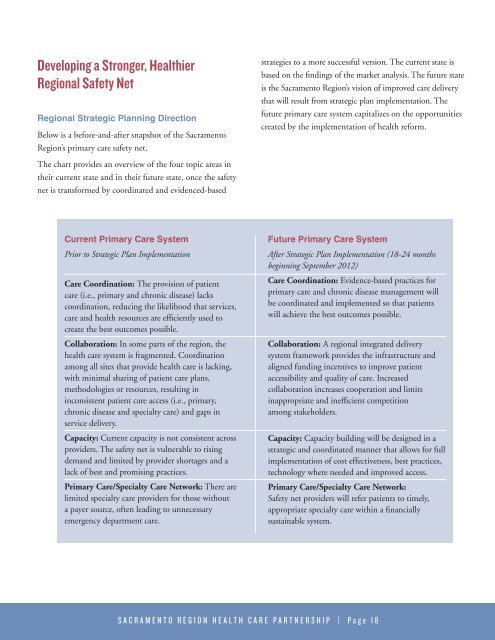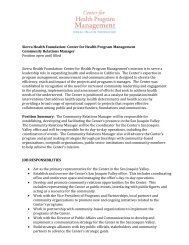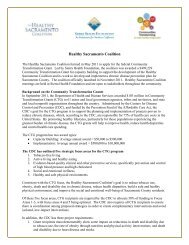Strategic Plan - Sierra Health Foundation
Strategic Plan - Sierra Health Foundation
Strategic Plan - Sierra Health Foundation
You also want an ePaper? Increase the reach of your titles
YUMPU automatically turns print PDFs into web optimized ePapers that Google loves.
Developing a Stronger, <strong>Health</strong>ier<br />
Regional Safety Net<br />
Regional <strong>Strategic</strong> <strong>Plan</strong>ning Direction<br />
Below is a before-and-after snapshot of the Sacramento<br />
Region’s primary care safety net.<br />
strategies to a more successful version. The current state is<br />
based on the findings of the market analysis. The future state<br />
is the Sacramento Region’s vision of improved care delivery<br />
that will result from strategic plan implementation. The<br />
future primary care system capitalizes on the opportunities<br />
created by the implementation of health reform.<br />
The chart provides an overview of the four topic areas in<br />
their current state and in their future state, once the safety<br />
net is transformed by coordinated and evidenced-based<br />
Current Primary Care System<br />
Prior to <strong>Strategic</strong> <strong>Plan</strong> Implementation<br />
Care Coordination: The provision of patient<br />
care (i.e., primary and chronic disease) lacks<br />
coordination, reducing the likelihood that services,<br />
care and health resources are efficiently used to<br />
create the best outcomes possible.<br />
Collaboration: In some parts of the region, the<br />
health care system is fragmented. Coordination<br />
among all sites that provide health care is lacking,<br />
with minimal sharing of patient care plans,<br />
methodologies or resources, resulting in<br />
inconsistent patient care access (i.e., primary,<br />
chronic disease and specialty care) and gaps in<br />
service delivery.<br />
Capacity: Current capacity is not consistent across<br />
providers. The safety net is vulnerable to rising<br />
demand and limited by provider shortages and a<br />
lack of best and promising practices.<br />
Primary Care/Specialty Care Network: There are<br />
limited specialty care providers for those without<br />
a payer source, often leading to unnecessary<br />
emergency department care.<br />
Future Primary Care System<br />
After <strong>Strategic</strong> <strong>Plan</strong> Implementation (18-24 months<br />
beginning September 2012)<br />
Care Coordination: Evidence-based practices for<br />
primary care and chronic disease management will<br />
be coordinated and implemented so that patients<br />
will achieve the best outcomes possible.<br />
Collaboration: A regional integrated delivery<br />
system framework provides the infrastructure and<br />
aligned funding incentives to improve patient<br />
accessibility and quality of care. Increased<br />
collaboration increases cooperation and limits<br />
inappropriate and inefficient competition<br />
among stakeholders.<br />
Capacity: Capacity building will be designed in a<br />
strategic and coordinated manner that allows for full<br />
implementation of cost effectiveness, best practices,<br />
technology where needed and improved access.<br />
Primary Care/Specialty Care Network:<br />
Safety net providers will refer patients to timely,<br />
appropriate specialty care within a financially<br />
sustainable system.<br />
S A C R A M E N T O R E G I O N H E A L T H C A R E P A R T N E R S H I P | P a g e 1 8













